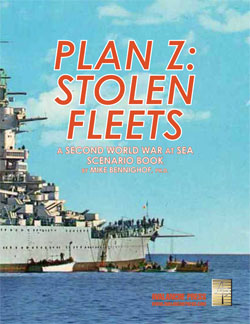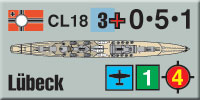| Stolen Fleets:
Soviet Cruisers
by Mike Bennighof, Ph.D.
January 2020
 It’s somewhat of a trope in wargames, the idea that a nation can greatly increase its fleet strength by capturing an enemy’s ships and putting them into service. That was definitely true in the age of wooden ships, when a great part (though not so great as sometimes claimed) of the Royal Navy had begun its service life under the fleur-de-lis or the tricolor. It’s somewhat of a trope in wargames, the idea that a nation can greatly increase its fleet strength by capturing an enemy’s ships and putting them into service. That was definitely true in the age of wooden ships, when a great part (though not so great as sometimes claimed) of the Royal Navy had begun its service life under the fleur-de-lis or the tricolor.
Once warships became massive machines powered first by coal and then by oil, it became far more difficult to take a captured ship into service. All of the many machines aboard, from the turbines to the range finders to the mechanical potato peelers, had come from a different source than those of their new owner’s ships. That made repairs and even simple maintenance difficult if not impossible - unless the entire supply chain had fallen into the new owner’s hands.
Smaller warships could more easily be taken over, and the German Navy made use of French, Dutch and Greek destroyers and torpedo boats as well as lesser craft. The Italians incorporated a small Yugoslav cruiser and several destroyers into their fleet, the Japanese operated formerly Chinese cruisers and an American destroyer, and the Soviets took over Romanian destroyers and river monitors.
Most of the ships taken into German service in Plan Z: Stolen Fleets are cruisers and destroyers rather than battleships. That’s mostly because there just aren’t that many battleships to be captured, but also due to the lighter maintenance load of a lighter ship. So let’s continue our look at the captured Soviet ships of Stolen Fleets.
Medium Cruisers

The Soviet Union built six cruisers of the Kirov class, two each for the Baltic, Black Sea and Pacific Fleets. They were small ships, displacing 7,800 tons built to an Italian design modified by the Soviets to overload them with more main guns. The guns themselves were 180mm (7.1-inch) weapons of Soviet make; the odd caliber came from a decision to re-line old 8-inch guns for the light cruiser Krasny Kavkaz. New guns were then designed to the same bore so that the same ammunition could be used.
Showing their Italian heritage, the cruisers were very fast, making 36 knots on trials (they had been designed for 37 knots, before the Soviets stuck more guns on them). They carried nine 7.1-inch Soviet-made guns, six torpedo tubes and anti-aircraft weapons. They were also fitted, unusually for a cruiser, to drop both mines and depth charges. Kirov had an Italian-made power plant; her sisters were powered by Soviet copies.
Kirov commissioned in 1938, and the second Baltic cruiser, Maksim Gorkiy, in December 1940. Both saw extensive service in the Winter War and the Great Patriotic War, mostly conducting shore bombardments in and around Leningrad. They both survived the war; Kirov to serve afterwards as a training ship until her disposal in 1974 and Maksim Gorkiy briefly as a test ship before she was scrapped in 1959.
In our Stolen Fleets story, Maksim Gorkiy would have been fitting out at the time Leningrad fell to the Axis, and Kirov under repair with both ships taken with minimal damage from sabotage. Like the battleship and battle cruiser, they would have also been towed to a German yard for repair and refitting. The 180mm/57 1932 Pattern naval rifle wasn’t a very good weapon, and it retaining it would have required also maintaining a whole supply chain for ammunition and spare parts.
Options for re-arming them would include triple mounts for the 170mm/40 naval rifle that had served as secondary armament on the last German pre-dreadnoughts and was still in use as a coastal defense gun, or the 150mm/48 KC/36 that armed the most modern light cruisers and some destroyers. Or they could remove the turret completely and replace it with the twin turret for the 203mm/60 SK C/34 that armed the modern German heavy cruisers.
Since that last fitting was still in production, that’s what we’ve given them in Stolen Fleets. They carry six 203mm guns in three twin turrets, making them rather small heavy cruisers, and a standard German array of 105mm and lighter anti-aircraft weapons. Replacing a warship’s turrets is no small task, and that keeps them out of German service until 1944 when they become available alongside the battleship and battle cruiser.
Big Light Cruisers

The Soviet Navy followed the small Kirovs with a much larger and improved version, the Chapayev class. Chapayev weighed in at 11,000 tons, about half again as much as Kirov, and was slightly longer and wider. Much of the additional weight went to greatly improved protection and to a revised main armament.
Chapayev carried a much more conventional armament of a dozen 6-inch Pattern 1938 guns, a Soviet-designed weapon also intended as secondary armament for Sovetsky Soyuz. As designed, she had six torpedo tubes, which were removed along with the aircraft catapult and hangar before she was completed after the Great Patriotic War, and a hefty anti-aircraft armament for a ship of her time.
The new cruisers would not be nearly as fast as Kirov, making 33 knots on 124,000 horsepower (the much smaller Kirov produced 113,500 horsepower) with a Soviet-made power plant. They were enormously more capable than their predecessor, but none would come close to completion before the war’s end.
Three cruisers were laid down in Leningrad for the Baltic Fleet in the late summer and autumn of 1938. One had been launched when the Great Patriotic War broke out and a second ship hit the water three days after the German invasion; work then stopped until after the war.
The Molotov-Ribbentrop Pact brought a number of changes to Soviet ships under construction; the Soviets believed that the Germans would supply them with triple turrets for their more effective 150mm/48 KC/36 gun and the associated range-finding and fire direction equipment. A re-design to incorporate these turrets was approved in October 1940 and work began to modify the ships to accept the German-made turrets and barbettes.
In our alternative history there is no such agreement, and the ships would still have been on the slipway when war breaks out in March 1940 and not nearly advanced enough to be worth completing. So like the big ships, we’re going to posit that the three cruisers were laid down at the beginning of the Third Five Year-Plan, and were afloat but incomplete at the start of our war that came early. Likewise they went to German yards for completion, including a German armament but they would retain their Italian-designed, Soviet-made turbines.
And those are the formerly Soviet cruisers of Stolen Fleets. Next time, we’ll look at Dutch cruisers and Soviet destroyers.
You can order Plan Z: Stolen Fleets right here.
Sign up for our newsletter right here. Your info will never be sold or transferred; we'll just use it to update you on new games and new offers.
Mike Bennighof is president of Avalanche Press and holds a doctorate in history from Emory University. A Fulbright Scholar and award-winning journalist, he has published over 100 books, games and articles on historical subjects.
He lives in Birmingham, Alabama with his wife, three children and his dog, Leopold.
|
